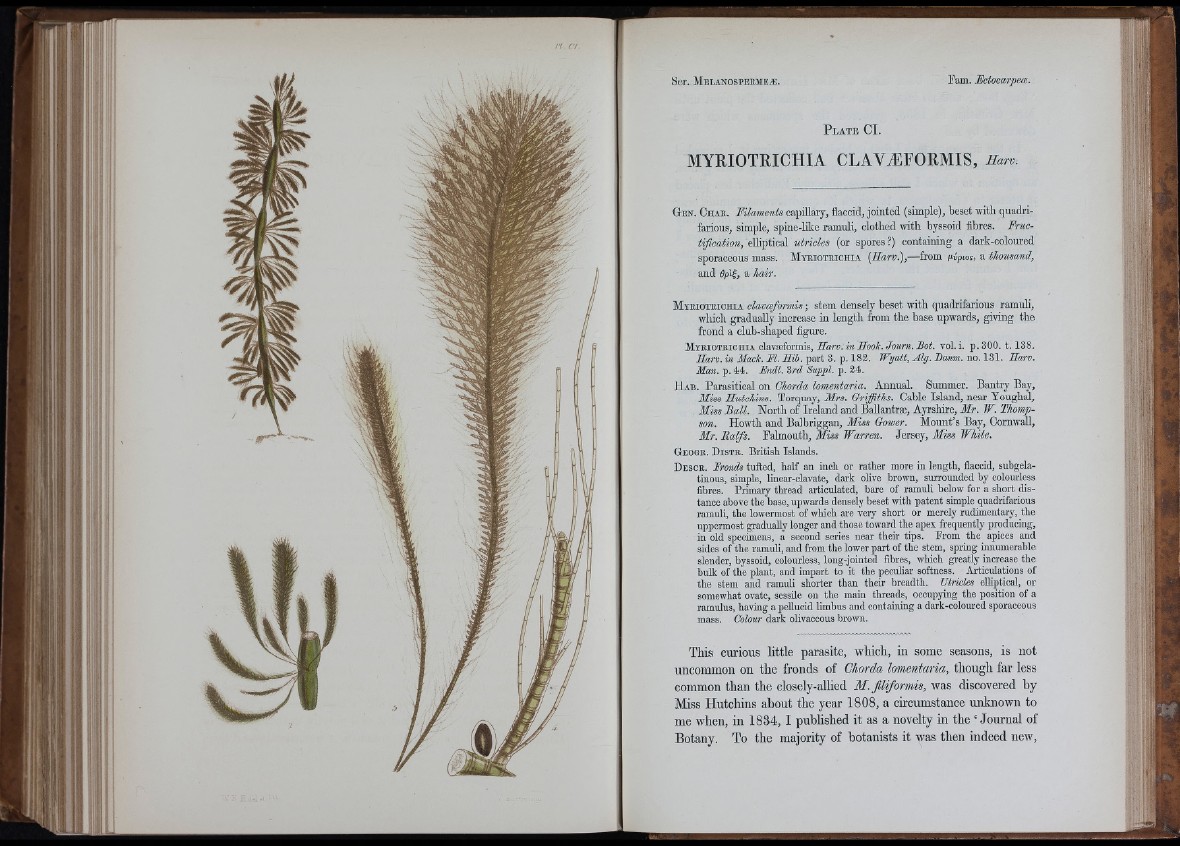
P l a t e CI.
MYRIOTRICHIA CLAVÆFORMIS, Harv.
G en . C h a r. Filaments capillary, flaccid, jointed (simple), beset with quadrifarious,
simple, spine-bke ramuli, clothed with byssoid fibres. Fructification,
elliptical utricles (or spores?) containing a dark-coloured
sporaceous mass. M y r io te ic h ia {Harv.),—from ¡ivpios, a thousand,
and i/j'if, a hair.
M y r io te ic h ia clavaformis ; stem densely beset with quadrifarious ramuli,
which gradually increase in length from the base upwards, giving the
frond a club-shaped figure.
Myrioteichia clavoeformis, Harv. in Hook. Journ. Bot. vol.i. p. 300. t. 138.
Harv. in Mack. M. Hib. part 3. p. 182. Wyatt, Alg. Banm. no. 131. Harv.
Man. p. 44. Bndl. 3rd Suppl. p. 24.
H a b . Parasitical on Chorda lomentaria. Annual. Summer. Bantry Bay,
Miss Hutchins. Torquay, Mrs. Griffiths. Cable Island, near Youghal,
Miss B all. North of Ireland and BaUantrse, Ayrshire, Mr. W. Thompson.
Howth and Balbriggan, Miss Gower. Mount’s Bay, Cornwall,
Mr. Balfs. Fahnouth, Miss Warren. Jersey, Miss White.
Geogr. Distr. British Islands.
Desoe. Fronds tufted, half an inch or rather more in length, flaccid, subgela-
tinons, simple, linear-clavate, dark olive brown, sun-onnded by colourless
fibres. Primary thread articulated, hare of ramuli below for a short distance
above the base, upwards densely beset with patent simple quadrifarious
ramuli, the lowermost of which ai-e very short or merely rudimentary, the
uppermost graduaUy longer and those toward the apex frequently producing,
in old specimens, a second series near then tips. Prom the apices and
sides of the ramuli, and from the lower part of the stem, spring innumerable
slender, byssoid, colourless, long-jointed fibres, which greatly increase the
bulk of the plant, and impart to it the peculiar softness. Articulations of
the stem and ramuli shorter than their breadth. Utricles eUiptical, or
somewhat ovate, sessile on the main threads, occupying the position of a
ramulus, having a peUucid limbus and containing a dark-coloured sporaceous
mass. Colour dark olivaceous brown.
This curious little parasite, which, in some seasons, is not
uncommon on the fronds of Chorda lomentaria, though far less
common than the closely-allied M. filiformis, was discovered by
Miss Hutchins about the year 1808, a circumstance unknown to
me when, in 1834,1 published it as a novelty in the ‘ Journal of
Botany. To the majority of botanists it was then indeed new.
I-Al